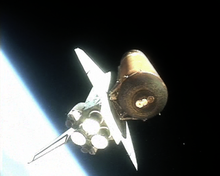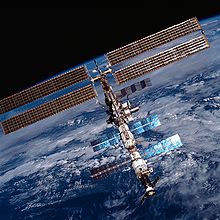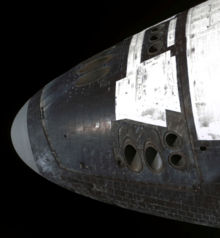Orbital spaceflight
This articleneeds additional citations forverification.(March 2008) |

| Part ofa serieson |
| Spaceflight |
|---|
 |
|
|
Anorbital spaceflight(ororbital flight) is aspaceflightin which aspacecraftis placed on a trajectory where it could remain inspacefor at least oneorbit.To do thisaround the Earth,it must be on a free trajectory which has analtitudeatperigee(altitude at closest approach) around 80 kilometers (50 mi); this is theboundary of spaceas defined byNASA,theUS Air Forceand theFAA.To remain in orbit at this altitude requires anorbital speedof ~7.8 km/s. Orbital speed is slower for higher orbits, but attaining them requires greaterdelta-v.TheFédération Aéronautique Internationalehas established theKármán lineat an altitude of 100 km (62 mi) as a working definition for the boundary between aeronautics and astronautics. This is used because at an altitude of about 100 km (62 mi), asTheodore von Kármáncalculated, a vehicle would have to travel faster thanorbital velocityto derive sufficientaerodynamic liftfrom the atmosphere to support itself.[1]: 84 [2]
Due toatmospheric drag,the lowest altitude at which an object in a circular orbit can complete at least one full revolution without propulsion is approximately 150 kilometres (93 mi).
The expression "orbital spaceflight" is mostly used to distinguish fromsub-orbital spaceflights,which are flights where theapogeeof a spacecraft reaches space, but the perigee is too low.[3]
Orbital launch
[edit]| Orbital human spaceflight | |||||||||||
| Spacecraft | First launch | Last launch | Launches | ||||||||
|---|---|---|---|---|---|---|---|---|---|---|---|
| Vostok | 1961 | 1963 | 6 | ||||||||
| Mercury | 1962 | 1963 | 4 | ||||||||
| Voskhod | 1964 | 1965 | 2 | ||||||||
| Gemini | 1965 | 1966 | 10 | ||||||||
| Soyuz | 1967 | Ongoing | 146 | ||||||||
| Apollo | 1968 | 1975 | 15 | ||||||||
| Shuttle | 1981 | 2011 | 134 | ||||||||
| Shenzhou | 2003 | Ongoing | 9 | ||||||||
| Crew Dragon | 2020 | Ongoing | 11 | ||||||||
| Total | - | - | 333 | ||||||||
Orbital spaceflight from Earth has only been achieved bylaunch vehiclesthat userocket enginesfor propulsion. To reach orbit, the rocket must impart to the payload adelta-vof about 9.3–10 km/s. This figure is mainly (~7.8 km/s) for horizontal acceleration needed to reach orbital speed, but allows foratmospheric drag(approximately 300 m/s with theballistic coefficientof a 20 m long dense fueled vehicle),gravity losses(depending on burn time and details of the trajectory and launch vehicle), and gaining altitude.
The main proven technique involves launching nearly vertically for a few kilometers while performing agravity turn,and then progressively flattening the trajectory out at an altitude of 170+ km and accelerating on a horizontal trajectory (with therocketangled upwards to fight gravity and maintain altitude) for a 5–8-minute burn until orbital velocity is achieved. Currently, 2–4stagesare needed to achieve the required delta-v. Most launches are byexpendable launch systems.
ThePegasus rocketfor small satellites instead launches from an aircraft at an altitude of 39,000 ft (12 km).
There have been many proposed methods for achieving orbital spaceflight that have the potential of being much more affordable than rockets. Some of these ideas such as thespace elevator,androtovator,require new materials much stronger than any currently known. Other proposed ideas include ground accelerators such aslaunch loops,rocket-assisted aircraft/spaceplanes such asReaction Engines Skylon,scramjetpowered spaceplanes, andRBCCpowered spaceplanes. Gun launch has been proposed for cargo.
From 2015SpaceXhave demonstrated significant progress in their more incremental approach to reducing the cost of orbital spaceflight. Their potential for cost reduction comes mainly from pioneeringpropulsive landingwith theirreusable rocketbooster stage as well as theirDragon capsule,but also includes reuse of the other components such as thepayload fairingsand the use of3D printingof asuperalloyto construct more efficient rocket engines, such as theirSuperDraco.The initial stages of these improvements could reduce the cost of an orbital launch by an order of magnitude.[4]
Stability
[edit]
An object in orbit at an altitude of less than roughly 200 km is considered unstable due toatmospheric drag.For a satellite to be in a stable orbit (i.e. sustainable for more than a few months), 350 km is a more standard altitude forlow Earth orbit.For example, on 1 February 1958 theExplorer 1satellite was launched into an orbit with aperigeeof 358 kilometers (222 mi).[5]It remained in orbit for more than 12 years before itsatmospheric reentryover the Pacific Ocean on 31 March 1970.
However, the exact behaviour of objects in orbit depends onaltitude,theirballistic coefficient,and details ofspace weatherwhich can affect the height of the upper atmosphere.
Orbits
[edit]There are three main "bands" oforbitaround the Earth:low Earth orbit(LEO),medium Earth orbit(MEO), andgeostationary orbit(GEO).
According toorbital mechanics,an orbit lies in a particular, largely fixed plane around the Earth, which coincides with the center of the Earth, and may be inclined with respect to the equator. The relative motion of the spacecraft and the movement of the Earth's surface, as the Earth rotates on its axis, determine the position that the spacecraft appears in the sky from the ground, and which parts of the Earth are visible from the spacecraft.
It is possible to calculate aground trackthat shows which part of the Earth a spacecraft is immediately above; this is useful for helping to visualise the orbit.
Orbital maneuver
[edit]
Inspaceflight,an orbital maneuver is the use ofpropulsionsystems to change theorbitof aspacecraft.For spacecraft far from Earth—for example those in orbits around the Sun—an orbital maneuver is called adeep-space maneuver (DSM).
Deorbit and re-entry
[edit]Returning spacecraft (including all potentially crewed craft) have to find a way of slowing down as much as possible while still in higher atmospheric layers and avoiding hitting the ground (lithobraking) or burning up. For many orbital space flights, initial deceleration is provided by theretrofiringof the craft's rocket engines, perturbing the orbit (by loweringperigeedown into the atmosphere) onto a suborbital trajectory. Many spacecraft inlow Earth orbit(e.g.,nanosatellitesor spacecraft that have run out ofstation keepingfuel or are otherwise non-functional) solve the problem of deceleration from orbital speeds through using atmospheric drag (aerobraking) to provide initial deceleration. In all cases, once initial deceleration has lowered the orbital perigee into themesosphere,all spacecraft lose most of the remaining speed, and therefore kinetic energy, through the atmospheric drag effect ofaerobraking.
Intentional aerobraking is achieved by orienting the returning space craft so as to present the heat shields forward toward the atmosphere to protect against the high temperatures generated by atmospheric compression and friction caused by passing through the atmosphere athypersonicspeeds. The thermal energy is dissipated mainly by compression heating the air in a shockwave ahead of the vehicle using a blunt heat shield shape, with the aim of minimising the heat entering the vehicle.
Sub-orbital space flights, being at a much lower speed, do not generate anywhere near as much[further explanation needed]heat upon re-entry.
Even if the orbiting objects are expendable, most[quantify]space authorities[example needed]are pushing toward controlled re-entries to minimize hazard to lives and property on the planet.[citation needed]
History
[edit]- Sputnik 1was the first human-made object to achieve orbital spaceflight. It was launched on 4 October 1957 by theSoviet Union.
- Vostok 1,launched by the Soviet Union on 12 April 1961, carryingYuri Gagarin,was the first successful human spaceflight to reach Earth orbit.
- Vostok 6,launched by the Soviet Union on 16 June 1963, carryingValentina Tereshkova,was the first successful spaceflight by a woman to reach Earth orbit.
- Crew Dragon Demo-2,launched bySpaceXand the United States on 30 May 2020, was the first successful human spaceflight by a private company to reach Earth orbit.
See also
[edit]- List of orbits
- Rocket launch
- Non-rocket spacelaunch
- Spaceport,including a list of sites for orbital launches
References
[edit]- ^O'Leary, Beth Laura (2009). Darrin, Ann Garrison (ed.).Handbook of space engineering, archaeology, and heritage.Advances in engineering. CRC Press.ISBN978-1-4200-8431-3.
- ^"Where does space begin? – Aerospace Engineering, Aviation News, Salary, Jobs and Museums".Aerospace Engineering, Aviation News, Salary, Jobs and Museums.Archivedfrom the original on 17 November 2015.Retrieved10 November2015.
- ^February 2020, Adam Mann 10 (10 February 2020)."What's the difference between orbital and suborbital spaceflight?".Space.Archivedfrom the original on 16 June 2020.Retrieved13 July2020.
{{cite web}}:CS1 maint: numeric names: authors list (link) - ^Belfiore, Michael (9 December 2013)."The Rocketeer".Foreign Policy.Archivedfrom the original on 10 December 2013.Retrieved11 December2013.
- ^"Explorer 1 – NSSDC ID: 1958-001A".NASA.Archivedfrom the original on 27 May 2019.Retrieved21 August2019.
